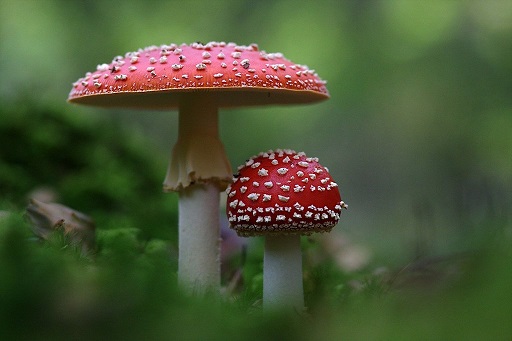
- A variety of mushrooms are found naturally growing on rotten logs of wood, dead barks of trees, fallow lands, forest beds, animal excreta etc.
- They differ in several characteristics and may be edible or poisonous.
- Mushroom poisoning caused by the ingestion of toxic mushrooms is called mycetism.
- About 30 wild species of mushrooms are known to be consistently fatal due to high levels of toxicity.
- Eating wild mushrooms is bad because they contain high levels of heavy metals, other chemicals and toxins which can trigger fatal health problems. Many people are not aware of the toxic and hallucinogenic effects of the wild mushrooms. We have heard people dying after the consumption of wild mushrooms as food.
- Some examples of poisonous mushrooms are:
- Amanita phalloides (Death cap)
- Amanita virosa (Destroying angel)
- Amanita muscaria (Fly agaric)
- Amanita verna (Fool’s mushroom)
- Amanita ceciliae (Snakeskin grisette)
- Amanita castanopsis (Red volva amanita)
- Galerina marginata (Funeral bell or deadly skullcap)
- Lepiota brunneoincarnata (Deadly dapperling)
- We should never eat a mushroom unless we can positively identify it as an edible one.
- Poisonous mushrooms look like edible mushrooms in their morphology and life cycle.
- Identification of mushroom is a must before using it as a food.
- There are not any reliable techniques to distinguish mushrooms as edible or poisonous. However, poisonous mushrooms generally exhibit the following features which help us identify them to some extent.
-
- Unpleasant and acrid smell
- Pileus and stipe are brighter or red in color
- Pileus develops a sticky/slimy surface and are not eaten by insects
- Presence of oozing milky or yellow latex
- Changes the color when scratched or cut
- Presence of an annulus and volva on the stipe
- While cooking and stirring mushroom with a silver spoon, the silver spoon changes to black color
- Irregular or wrinkled pileus looking like a saddle
- The umbrella or parasol-shape has white rings around the stipe
- Appear brighter in color in the young stage but become brown as they get older
- White or green colored gills
- Yellowish green or pink colored spores
-
- These features aren’t definitive because many edible species also display these characteristics, but if we notice them, they are a good indication that we should leave the mushroom alone and not eat them.
References:
- https://www.worldatlas.com/articles/8-most-poisonous-types-of-mushrooms.html
- https://sciencing.com/identify-poisonous-mushrooms-2057768.html